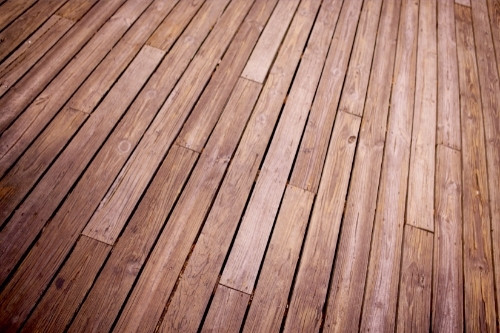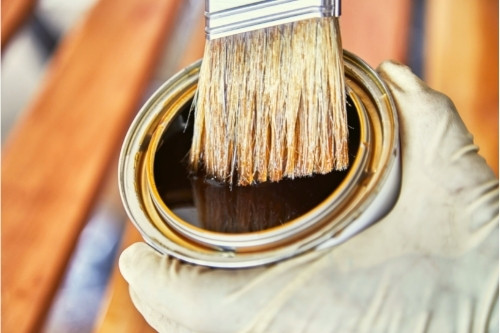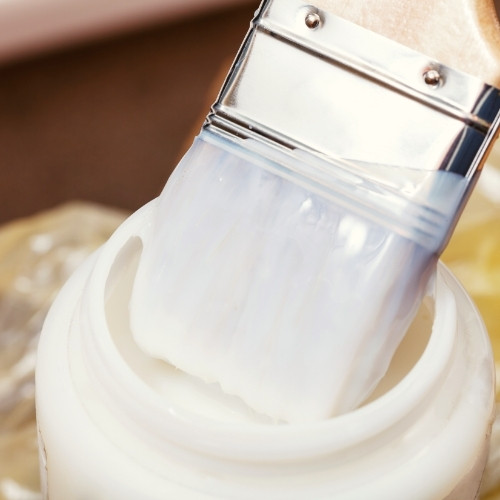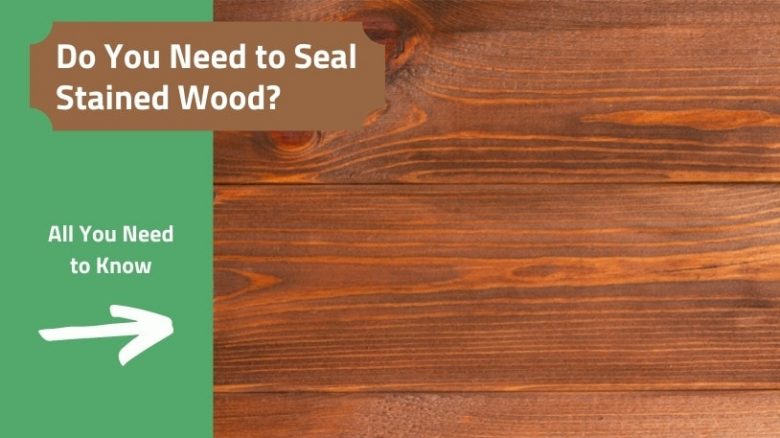There is no rule to say you must seal wood after staining. However, while stain colors the wood and raises the grain, it doesn’t protect the underlying timber. So no, you don’t have to seal stained wood, but I strongly advise you to.
I’ve been woodworking for many years, and when I started, I often stained outside furniture. Within a short time of being exposed to the elements, the wood dried and cracked, shortening the furniture’s life. I don’t make that mistake now; after staining an item, I make sure to apply a protective topcoat to prevent deterioration.
In this article, I’ll run you through the benefits of applying a sealer coat to stained wood and give you some tips to be aware of before you start.
After staining the wood, do you have to seal it?
If you wish your project to last a while, you need to apply a form of sealer. While some stains do contain sealers and UV blockers, they offer only a partial solution. Always apply a protective coat to protect your wood from rot and cracking.
Why does wood have to be sealed after staining?
Most wood we use for projects has poor durability, lasting five to ten years before it decays. Well before your wood rots, it will begin to dry, crack, and warp from exposure to UV and humidity changes in the surrounding environment.
While stain makes the wood darker and gives better grain definition, it offers little to no protection against the environment. Applying a couple of sealer coats on top of the stain closes the wood pores, slowing the takeup of moisture, blocking some UV, and delaying deterioration. You will give the timber a considerably longer life if you sand and reapply the sealer coat every few years.
A sealer coat will also protect the wood from wear and impact, particularly in a high-traffic area. When wooden floors are laid and stained, it’s normal to apply three to four coats of polyurethane. It lifts and enhances the color, protects the wood from impact and wear, and prevents scuffing and scratching.
There’s also an aesthetic reason to apply a topcoat. Without sealer, the color of the stained timber will look flat and lifeless. Applying a sealer will make the color pop more, intensifying both the color and grain.
Finally, a sealer coat will protect your wood from being stained by spills and marks. If you’ve applied only a wood stain, the wood’s pores remain open. Spill a cup of coffee, and it rapidly soaks into the wood, leaving a stain mark that will be hard, if not impossible, to remove. With a sealer coat applied, the coffee sits on the surface of the topcoat and may be wiped off without damaging the underlying timber.
What if you don’t seal stained wood?

A lot depends on where you will use the item. If it’s hanging inside on a wall, out of harm’s way, expect it to split, warp, and fade in time due to UV light and humidity. That aside, the impact will not be dramatic.
However, if used in an area exposed to water, high foot traffic, or spillage, you can expect a more rapid deterioration. Rot, scratches, wear, denting, and staining will quickly make the item look old. Now, you may like the ‘distressed’ look but be prepared to replace the item more frequently than you would had it been protected.
What can you put over stained wood to seal it?
Practically, you have three options.
- Oil-based polyurethane
- Water-based polyurethane
- ‘Varnish’ or alkyd
While you can apply waxes and hard-drying oils, there are some tips and traps. It’s very labor-intensive to apply, and maintenance and upkeep are greater than the polyurethanes and alkyds. If you’re keen on these options, I’ve written this article to assist you with an in-depth understanding of applying surface finishes to waterproof wood.
However, let’s touch lightly on each of our three options above.
Oil-based polyurethane

Oil-based polyurethane is ideal for applying over the top of stained wood, particularly if you use the item outside or it will be exposed to moisture, such as in a bathroom. Oil-based polyurethane is also resistant to heat and scratching, so it’s a good choice in high-traffic areas. When using a dark stain, use an oil-based polyurethane, as its slight amber tint richens the color of the stain.
Be careful if you’re applying oil-based polyurethane over a water-based stain. Water-based stains sit on the surface of the wood rather than soak into the fibers as an oil-based product does. You must ensure the water-based stain is fully dried; otherwise, applying the polyurethane can lift the stain. This article gives you all the information you need when selecting and applying oil-based and water-based polyurethane.
Water-based polyurethane

You can apply water-based polyurethane over both water and oil-based stains. Water-based polyurethane is thinner to apply, quicker to dry, and, once dry, is more resistant to impact than oil-based products. Be sure the stain has fully cured before you apply the topcoat.
Learn More: How Long Does Polyurethane Take to Dry
Use water-based polyurethane over lighter stains or when you don’t want the stain color altered in any way. Water-based polyurethane is clear and doesn’t add a tint or cast to the underlying color.
Alkyd, or varnish
Alkyd is a waterproof, flexible, and hard-wearing topcoat for stained wood and offers good UV and moisture resistance, being ideal for external use. Like polyurethanes, alkyds come in oil and water-based choices, with the same caveats for their application. Some products contain hard-drying and soft-drying oils, with the minor drawback being that they take longer to dry than the polyurethanes mentioned.
How to seal wood stain
You must be sure the stain is properly dry before applying the sealing coat. I’m assuming that you’ve stained the wood yourself, which means you’ll have prepared the surface by cleaning and sanding it before applying the stain.
Related: How long to let stain dry before polyurethane?
If not, or if the stained wood has been sitting exposed for some time, you must ensure the surface is clean and dry. I like to lightly wipe the surface down with a dampened cloth to ensure no surface contamination before I begin. Dry the surface with a lint-free, dry cloth.
When the stain is a water-based product, and you’re applying oil-based polyurethane or alkyd, it’s worth applying a thin sealing coat of shellac as a first topcoat. Water-based stains sit on the surface of the timber when dry and can easily be rubbed off or lifted by the solvents in oil-based products. Shellac seals the stain without lifting it. Once dry, the polyurethane or alkyd adheres well to the shellac.
Decant the liquid finish into a clean container. Water-based polyurethane doesn’t need thinning as it is already thin enough if it’s an oil-based polyurethane or alkyd, thin it at a ratio of 50/50 using mineral spirits.
Apply the first coat using a brush, working in the direction of the grain. Don’t overwork the coating; get the coverage you need and leave it alone. It needs time to flow and level before drying.
Follow the manufacturer’s directions for recoat times, but expect one to two hours for water-based coatings and three to four hours for oil-based. Once the wood is ready for the second coat, lightly scuff the surface with 200-grit sandpaper to give a keying surface, vacuum, and wipe the surface to remove all dust.
Apply a second coat in the same manner as before. However, thin the oil-based finishes at 75% finish to 25% mineral spirits.
Repeat the previous two steps until you have the required number of coats. Allow the last coat to dry off completely for 24 hours. Do not sand the last coat.
Related: How many coats of polyurethane to apply?
Do you need to put a clear coat on stained wood?
No, no rule says you must. If the item is not subject to moisture, high humidity, heat, UV, or heavy use, you can stain the wood and leave it be. Be aware, however, that the wood is likely to split or warp with changes in temperature and humidity. The appearance of the stained wood will also be flat and a bit subdued, as stain colors are designed to be viewed under a clear coat.
A clear coat wraps the wood in clear plastic protection. It slows down rot and fading while protecting the wood against heat, scratching, spills, and splitting. Using a clear coat will prolong the life of your wooden item.
What topcoat is best to use on stained wood?
The following are the parameters I’d use to choose an appropriate topcoat.
Use an oil-based polyurethane or alkyd when:
- You intend to use the stained item outside
- Budget is important
- The item is subject to wear or scratches
- The stained wood is a darker color
Use water-based polyurethane or alkyd when:
- The item is subject to impact or denting
- A quick drying time is needed
- The stained wood is a light color
- You want an environmentally-friendly solution
DIY wood staining tips
- Be aware of wood moisture. Be sure the wood has a moisture content of 12% or lower. If the wood is too wet, the finish will appear blotchy. To check the moisture content, place a few drops of water onto the surface of the wood. If the wood absorbs the water, it is dry enough to stain. If the water beads on the surface and is still there a few minutes later, it needs to dry further.
- Surface preparation. Prepare the surface of the wood to achieve the look you desire. You don’t need to sand the wood before staining; you can only do so if you want a smoother finish.
- Clean the wood. Clean the surface with a mild soapy water solution, allow it to dry naturally, or wipe it dry with a lint-free cloth. Ensure the wood is fully dry before staining.
- Stir the stain thoroughly before use. Apply two thin coats of stain using a brush or roller, allowing an hour between each coat. Allow 48 to 72 hours before applying a sealing coat.
- Watch out for drips. Clean up any drips or runs as you apply the stain. Keep a brush handy for this purpose; otherwise, the appearance of the stain will be compromised.
- Minimize overlaps. Don’t overlap wet stain onto dry stain during application, as you’ll end up with darker broad bands from the overlapped area. Keep edges wet and minimize overlaps.
Related: How to Stain Wood for Beginners
FAQ
Does stain seal wood?
No. Water-based stains allow the wood pores to remain open. Oil-based stains do block the pores a little, but not to the degree that a clear topcoat does.
How long to let the stain dry before sealing?
I like to let the stain and wood dry fully before sealing. I usually wait for 48 hours, although it may take longer in cold or damp climates.
What happens if you seal the wood before the stain has dried?
You will compromise the adhesion of the sealer, making it more likely to peel or flake. If the stain is very wet, you may end up with neither the stain nor the sealer coat drying properly. You’ll be forced to remove the sealer and the stain, sand the wood, and begin the entire application process from the beginning.
Do you have to put polyurethane over the stain?
No. However, be aware that wood-stain offers no environmental protection to wood. Your timber will be subject to rot, splitting, or warping while being easily scratched or dented. Also, the stain will not be as deep and vibrant as when you’ve applied polyurethane.
Conclusion: Stained Wood Has to be Sealed
Sealing stained wood offers so many benefits and threatens so many drawbacks if not done. I make a point of providing surface protection whenever I apply stain. One last warning, however. Do not confuse sanding sealers with topcoat sealers such as polyurethane. The two are very different, and if you apply a sanding sealer to your stained wood, you won’t get the environmental protection or the same defense from scratches, heat, staining, and wear.
Two or more coats of polyurethane or alkyd will not only enhance the color and richness of the wood stain but they’ll also ensure you get to enjoy the item for many more years. Good luck with your project, and I hope this information was helpful.

